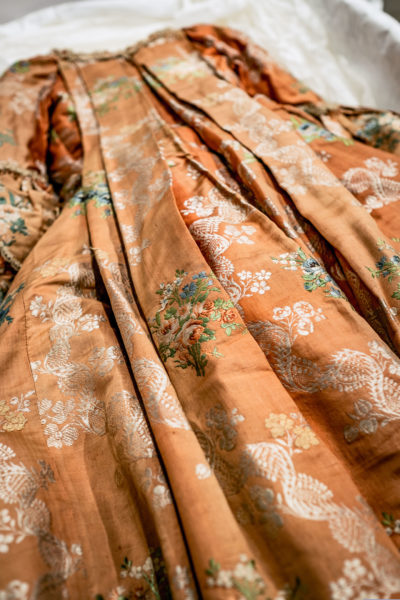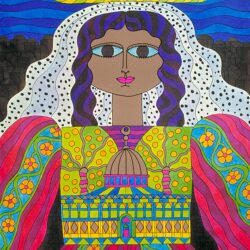Innovation in the MoMu Depot: Efficient and Sustainable Conservation

Today, more than 35,000 objects in the MoMu Collection are stored in an external storage that measures 1,300 m². Thanks to this external solution the museum is able to preserve the collection in the most optimal climate conditions, always with an eye to sustainability. Because the museum itself does not have enough room for storing the entire collection, 70% of MoMu’s extensive collection of historical and designer textiles have been moved to the outskirts of Antwerp, while the library archives and the more delicate plastic collection have remained in their former locations in the museum, so that MoMu is able to follow up on the condition of the objects. MoMu Textile Conservator Kim Verkens tells us about a number of new developments.
To optimize the preventive conservation in the storage, one of the things we look at is how other museums deal with this issue. For conserving shoes, for example, we were inspired by New York’s Metropolitan Museum of Art. We are always searching for ever more sustainable solutions, so that we create less waste and conserve the objects more economically.

Suicidal combs
KIM VERKENS: "The plastic objects are kept here in the museum, where we store them according to the type of material. At the moment, they are being identified and sorted according to one of the five problem groups (cellulose acetate, cellulose nitrate, polyvinylchloride, polyurethane and natural rubber). Plastics are preferably stored under different climate conditions than textiles: a drier relative humidity of between 40% and 50%, and a lower temperature, between 16° and 18°C. We have divided this in-house storage into two zones, with one section for general plastics and a smaller space for preserving cellulose nitrate and cellulose acetate. That category includes, for example, historical hair combs from the late 19th and early 20th centuries.
The combs themselves are constantly releasing harmful acids, which accelerate the degradation of the object itself and pose a threat to other objects nearby. That area is kept even drier – with a relative humidity between 20% and 30%, and the air refreshed daily. This way, we ensure the best possible preservation, slowing the degradation process and extending the life of the object."
We have also made four other changes for the conservation of the objects at the external storage."
Shoes in drawers
KV: "We used to store all the shoes in individual, acid-free boxes. The outline of the shoe was cut out of a supporting sheet of plastazote – a light, gently springy polyethylene foam – about a centimetre thick. However, the shoes still fell over and did not have enough support when they were being transported. They have recently been placed on acid-free honeycomb cardboard, and are further supported with much smaller pieces of plastazote around the tip and heel of the shoe instead of using an entire sheet. High heels receive an extra support by the use of a thicker piece of plastazote that fits underneath the opening of the heel, this creates a lot of stability. Since only small pieces of plastazote are being used now we’ve optimized our use of materials and work more economically. At the same time, the shoes are better supported, and they are less likely to fall over.
Another change is that we are no longer storing the shoes in acid-free boxes, but in drawers. This means that we can place multiple pairs in rows. Just open up a drawer and one can immediately see the shoes. You can see the object you need and easily take it out. This method has three advantages: the shoes are kept more stable; we can check them better because we do not have to open any boxes to see what we are looking for; and less material is being used, which is better for the environment.
Another important difference is that the shoes themselves no longer have to be manipulated. The less an object is handled, the better, certainly if it is already in poor condition. If a pair of shoes is requested for a loan, for example, we can pick them up by the cardboard that supports them and place it all together in a box, ready to travel. We would in fact also like to use these drawers for other objects in the future."
Transparency on a roll
KV: "For flat textiles that are rolled, we were looking for an alternative material to protect the outsides of the rolls. We had to unroll the objects too often, just to see what was inside. Instead of Tyvek – a thin plastic textile made of polyethylene – we are now using transparent melinex, a polyethylene foil. We can now see at a glance which fabric is on which roll, again with the advantage that there is less manipulation involved. In the storage, there is a good overview of all the rolls. They are hanging on bars attached to a mesh wall used for storing paintings. We had been aware of this problem for a while, but it has only been since we have the new storage that we have invested in more functional and sustainable storage methods. Efficiency is very important here: we have a large collection with a not-so-large staff. The new methods mean that we can work faster and more efficiently with the object always kept in consideration."


Custom made boxes
KV: "There are costumes in our collection that are longer than the standard-format, acid-free storage boxes. In the past, we were creative by manually constructing larger boxes from two smaller ones. Unfortunately, these boxes only remain acid-free for ten years, so it was necessary to purchase more and make up new boxes every decade. That involved a lot of waste and labour. For that reason, we now bought custom made boxes, from a far more durable material that is intended to be permanently acid-free. They are of course also much sturdier than our homemade constructions. Our intention is to transfer all our costumes to these new boxes, so we can store them in optimal conditions.
In addition, inside the boxes, we want to use more cotton and tricot and less acid-free paper. If the paper is not replaced soon enough, it begins to yellow, and that can affect the object it’s meant to protect. Replacing the paper at regular intervals is labour-intensive and involves a lot of waste. Also, we have other costumes currently hanging inside protective covers made of Tyvek. Some of these include certain materials or fabrics, and we eventually want to switch to cotton covers for them as well. Synthetic materials such as Tyvek can be detrimental for certain plastics, such as P-PVC where it is known to extract the plasticizer."









